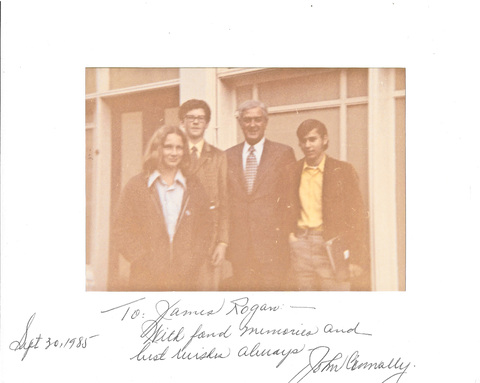
Here I am with Governor Connally (then heading "Democrats for Nixon"), along with two buddies since junior high school: Dan Swanson (center) and Alex Pava (at right), October 12, 1972. Look closely and you will see a George McGovern campaign button on my sweatshirt!
[Adapted from my book Shaking Hands with History]
Over the years, I came to meet or know about ten people who rode in President John F. Kennedy's fateful motorcade through Dallas on November 22, 1963. Of all of them, I once met the man with whom I wanted to talk the most about that day. Unfortunately, our encounter was not under circumstances that allowed me to ask former Texas Governor John Connally about his recollections of riding with Kennedy in the presidential limousine (the vehicle identified by the Secret Service as SS-100-X).
Born in Texas in 1917, Connally served in the Navy during World War II. Later, he obtained a law degree and became an aide to his longtime friend, Lyndon Johnson, during LBJ's congressional years. At Johnson's urging, Kennedy named Connally as secretary of the Navy in 1961, a position he held until he resigned the following year to run for Texas governor. He went on to win three consecutive terms in the statehouse, and in this capacity, he welcomed the Kennedys to his home state in November 1963.
When the presidential motorcade departed Love Field for downtown Dallas, Connally sat in the jump seat of SS-100-X directly in front of Kennedy. According to the official Warren Commission report, the assassin's second shot passed through Kennedy's neck and throat, and then it struck Connally's back, exited his chest, blew through his wrist, and then lodged in his thigh. Although seriously wounded in the shooting, Connally survived.
President Nixon named Connally (still a Democrat at that time) as his secretary of the Treasury in 1971. Sixteen months later, he resigned to head "Democrats for Nixon" for the Republican president's 1972 reelection campaign.
Three weeks before Election Day 1972, Connally came to San Francisco as a Nixon campaign surrogate to campaign against the Democratic presidential nominee, Senator George McGovern. Along with two school friends (Dan Swanson and Alex Pava), I waited outside KGO at dawn for him to arrive. The sun was just rising when a black stretch limousine pulled to the curb. We were his only welcoming committee when he exited the car.
Connally had a commanding, dignified presence. He was tall, with wavy white hair and a deep baritone voice. That he survived one of the most infamous crimes in American history added to his mystique. While shaking hands with the same man I had seen depicted in countless photographs seated with Kennedy in that blue Lincoln, I felt both awed and awkward. I wanted to ask about his experience on that fateful day, but when my opportunity arose, I fumbled about for a way to approach the sensitive subject. If I ask him about Dallas, will it upset him? Will it cause some traumatic reaction? I lost my nerve.
Connally stood on the sidewalk and signed autographs for us, which created for me an unexpected distraction. As his hand moved across our souvenirs, I stared at his wrist looking for the scars from the bullet's entrance and exit wounds. I couldn't see them, so subconsciously I started leaning closer and closer. While I fixated on his wrist trying to spot his gunshot scars, I noticed that his hand had stopped moving suddenly. A deep voice asked, "Is something wrong, son?"
I snapped back to consciousness with a start. Without realizing it, I had positioned my face about three inches from his hand! Now embarrassed, I glanced upward and saw Connally looking at me quizzically.
"Son? Are you okay?"
"Oh, I'm sorry governor, I was—I was—I was admiring your cufflinks! And I'm farsighted. I just wanted to get a good look at them. Boy, they sure are beauties."
"My wife gave them to me. I'll tell her you like them." He posed for a group picture, and then he disappeared inside the studio.
Damn! John Connally stood with me on a deserted street, but I was a kid and I lost my nerve. I never asked my questions. That was too bad because the opportunity never returned.
Although John Connally and I never met again, I still got to see in person the man in the jump seat, along with a very, very good look at a nice pair of cufflinks.
• • •
President Nixon had hoped to make John Connally his new vice president after Spiro Agnew resigned in 1973, but the Democrat-controlled Congress signaled it would not confirm the man who had abandoned their Party to align himself with Nixon. In 1980, Connally ran for president as a Republican, but he garnered only one delegate to the national nominating convention. He died at age 76 on June 15, 1993 of pulmonary fibrosis.
* * * * *